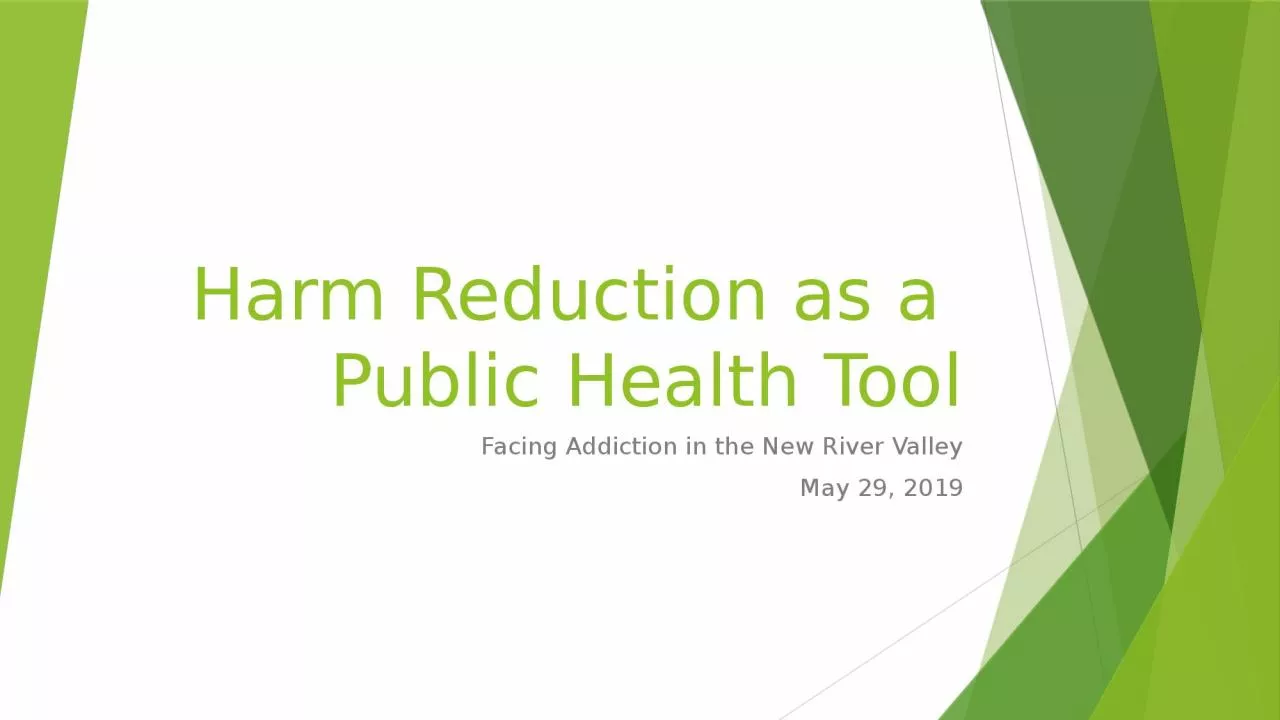

Facing Addiction in the New River Valley May 29 2019 Michael E Kilkenny MD MS Physician Director CabellHuntington Health Department 703 7 th Ave Huntington WV 25701 304 5236483 michaelekilkennywvgov ID: 1045183
Download Presentation The PPT/PDF document "Harm Reduction as a Public Health Tool" is the property of its rightful owner. Permission is granted to download and print the materials on this web site for personal, non-commercial use only, and to display it on your personal computer provided you do not modify the materials and that you retain all copyright notices contained in the materials. By downloading content from our website, you accept the terms of this agreement.
1. Harm Reduction as a Public Health ToolFacing Addiction in the New River ValleyMay 29, 2019
2. Michael E. Kilkenny, MD, MSPhysician DirectorCabell-Huntington Health Department703 7th AveHuntington, WV 25701(304) 523-6483michael.e.kilkenny@wv.gov
3. DisclosuresNone
4. ObjectivesParticipants will be able to list 3 benefits of harm reductionParticipants will be able to list 2 components of successful harm reduction implementationParticipants will be able to list 2 measures of harm reduction program success
5. The ProblemsHigh Rates of Overdose DeathHigh Rates of Hepatitis BHigh Rates of Hepatitis CHigh Risk of HIV OutbreakHigh Rates of Neonatal Opioid Withdrawal SyndromeHigh Rates of Drug-related IncarcerationHigh Rates of Utilization of Foster Care
6. So, What Helps?Top of the PyramidNaloxoneSyringe ServicesUser EducationDisease TestingReferral and Treatment(These are All Elements of Harm Reduction)
7. What Else Helps?Middle of the PyramidImmunizationsPublic EducationPrescription Drug Monitoring Programs“Good Samaritan” Laws
8. More Things that HelpBottom of the PyramidHigher High School Completion RatesEconomic Development
9. Now Let’s Focus on Harm Reduction * = Evidence Based InterventionNaloxone – Targeted Naloxone Distribution*Community Naloxone DistributionPersons at high risk of witnessing overdoseFirst RespondersEMS, Police, Fire, OutreachCo-prescribingPersons prescribed high dose opioids
10. Remember, * = Evidence Based InterventionSyringe Services*Syringe Service participants are 5 times more likely to enter drug treatment and 3.5 times more likely to cease injecting than those who don’t.Effective in reducing the spread of hepatitis C, hepatitis B, and HIV.Serve as a resource for clinicians, law enforcement, judicial system programs and social programs.
11. Did you say something about Education?Education of UsersEducation of injection drug users can alter their drug using behaviors.*Fentanyl testing and education can reduce overdose risk.Harm reduction clients frequently express appreciation of education regarding infection risk, skin care, injection technique, infection treatment.Education regarding substance use treatment options can encourage Medication Assisted Treatment*
12. How does Disease Testing Help?Disease TestingThe Cabell-Huntington Harm Reduction Program provides opt-out testing of new clients and 3 month reminders for repeat testing for HIV negative clients.CHHRP offers time of visit STD testing for most harm reduction visits.
13. ReferralCHHD offers referral for disease management for HIV, hepatitis, and other complications of injection drug use when present.CHHD offers Pre-Exposure Prophylaxis against HIV on-site.During a 9 month period in 2018, CHHRP referred more clients to substance use treatment (including MAT*) than it accepted as new clients.
14. Setting up Harm ReductionReview Applicable HRP Guidelines and Certification Procedures.Assess Community Need and ReadinessBuild Community SupportAddress Waste Management for Syringe Disposal
15. Community Need and ReadinessReview community level dataVital Statistics ReportsOther health reportsLocal expertsLaw enforcement, prosecuting attorneys, drug courts, EMS, Emergency departments, infectious disease specialists, county health departments, drug user unions…
16. Address medical waste requirementsIf you provide syringe services and accept returned syringes, you will have to assess your medical waste status and likely adjust it to “Large Producer.”Review your waste management certification and requirements.CHHRP’s process required staged approvals and public notification periods. This can take 90 days or more. CHHRP provides and collects thousands of pounds of syringes. What would your program handle?
17. The Results Can Be AMAZING!Community partnerships are formed and strengthened.Political support can be gained.Workforce can be energized.Client engagement can be rewarding.Outcomes are visible.
18. Data Source: Cabell-Huntington Health Department* 2018 Data preliminary through August 20, 2018Change in case definition
19. Local Overdose Death TrendsData Source: WV Health Statistics Center, 08/15/2018 Update. *Data Preliminary and incomplete. Care should be taken regarding conclusions drawn from preliminary data.
20. ResourcesCenters for Disease Control and Prevention. Evidence-Based Strategies for Preventing Opioid Overdose: What’s Working in the United States. National Center for Injury Prevention and Control, Centers for Disease Control and Prevention, U.S. Department of Health and Human Services, 2018. Accessed [date] from http://www. cdc.gov/drugoverdose/pdf/pubs/2018-evidence-based-strategies.pdfSherman, S.G., Park, J.N., Glick, J., McKenzie, M., Morales, K., Christensen, T., Green, T.C. (2018) FORECAST Study Summary Report. Johns Hopkins Bloomberg School of Public Health.https://harmreduction.orghttps://dhhr.wv.gov/oeps/harm-reduction/Pages/default.aspxhttps://dhhr.wv.gov/oeps/harm-reduction/Documents/AUGUST%202018%20CERTIFICATION%20GUIDELINES_FINAL.pdf